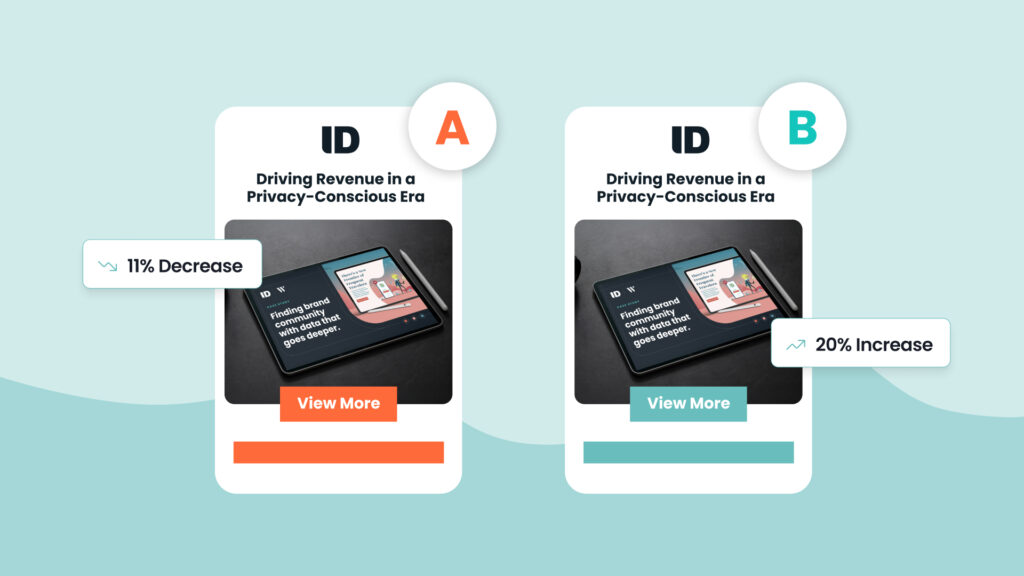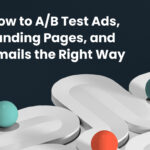A/B testing is a go-to tactic for many B2B marketers. But too often, it’s tacked on as an afterthought. The result? Wasted time, muddy data, and zero real learning.
At Intelligent Demand, we see A/B tests as their own initiative—with dedicated goals, hypotheses, and success metrics. By giving tests their just due, we go beyond simply validating creative preference, to truly unlocking insights that drive impact.
And sure, there’s lots of content out there on this topic. But most only skim the surface. We’ll walk you through how to A/B test correctly—giving you specific use cases and actionable guidance to run smarter tests in ads, emails, and landing pages, without wasting time or budget.
The TL:DR of What You Need To Know
A great A/B test should begin with a hypothesis you’d like to dig into. The point isn’t just to beat a control—it’s to uncover tactics that improve performance (that you can repeat again and again).
In addition to deciding what you want to test, there are some universal hard and fast best practices you’ll want to follow to ensure success.
These golden rules always apply:
- Define your success metric upfront—CTR? Conversions? Time on page?
- Test one variable at a time (or you won’t know what produced the change)
- Split your audience and budget evenly between variants
- Make sure you have enough traffic volume to reach significance
- Document everything. What did you learn, and what will you test next?
When Not to Test:
On the flip side, if you can’t meet most of the criteria above, it may not be the right time for a test. Work on checking everything off that list first.
The A to Bs of Getting the Most Out of Your Ads
Ads may be the easiest place to run a test, but they’re also one of the easiest to get wrong. This is because we often change design and copy together, reallocate budget mid-test, or stop the test too early to gather significant data.
So why run an A/B test in ad format?
Some of the best use cases are to test messaging and brand look or feel. Ads are a great medium for learning what matters most to your prospects, and what causes them to stop scrolling, engage, and ultimately connect with your brand.
Ideas on what to test:
- Minor messaging changes: one benefit vs. another
- Value prop focus: cost vs. time savings
- Copy tone: straightforward vs. sassy
- CTA phrasing: “book a demo” vs. “see it in action”
- Static vs. animated creative
- Different brand colors
- Imagery types: people vs. product
Here’s an example of an ideal ad A/B test. Why? Because the messaging and the design are nearly identical. This is what we mean by changing one variable only. The difference we’re testing here is whether people care more about gaining knowledge or gaining revenue.

Pro tip: It’s best to apply tests to campaigns with ≥1,000 clicks per variant, that are showing some ad fatigue (dropping CTRs, higher frequency).
Is Your Landing Page Leaking Conversions? Test It.
Landing pages are your sale closers—they’re where interest turns to action. And that’s exactly why they deserve a testing strategy of their own. And if you’re seeing high traffic but low conversions, testing isn’t optional—it’s essential.
So, where do you start?
First, identify what kind of traffic you’re sending to the page. Is it warm traffic from a nurture? Cold clicks from paid social? Your test should account for that. If you’re rolling out a new product or offer, test early to ensure your message lands before scaling.
What to test:
- Headline or benefit copy: feature-led vs. benefit-led
- CTA placement or wording: “get the report” vs. “download now”
- Form placement and number of fields required
- Visual elements: showing the product vs. showing the user
- Layout or hierarchy: a benefit-led layout vs. feature-led
- Page length: long-form storytelling vs. short and scannable
- Interactivity: traditional static content vs. quizzes, videos, etc.
Where most teams go wrong is changing too much at once—new copy, new layout, new CTA, all in the same test (sensing a theme yet?). This makes it impossible to isolate what’s actually driving performance. Another common issue is testing on low-traffic pages where you can’t ever reach significance. Don’t spend weeks testing a page that gets 50 visits a month.
When Your Emails Stop Working, Start Testing
If you’re sending marketing emails regularly (and you are, right?), you’ve got a built-in testing machine. But email testing in B2B can get tricky fast. By now, this should come as no surprise—the biggest misstep is testing everything at once. But there are other factors that need to be met for a successful test too.
Remember, volume matters.
If you don’t have at least 1,000 recipients per version, don’t expect meaningful conclusions. But when you do, testing can reveal how your audience prefers to be spoken to—urgency vs. education, short vs. detailed, formal vs. casual.
What to test:
- Subject line: different tones, lengths or formats
- Body length: succinct vs. detailed
- Message angle: is urgency or education more effective?
- Design layout: text-heavy vs. image-led
- CTA placement: top, bottom, or multiple click points?
Pro tip: If your subject line is underperforming, try testing a question format vs. a statement. For example, B2B tech buyers often respond better to a question that hints at value.
A/B Testing Should Be a Strategy, Not a Side Order
As you can see, testing isn’t hard—but doing it well requires intention and proper planning. When used correctly, it becomes one of the most powerful ways to optimize campaigns, sharpen creative outputs, and improve performance across the board.
Whether you’re focused on ads, emails, or landing pages, the best-practices are the same: pick one variable, tie it to a real goal, and run your test long enough to learn something meaningful.
Want the fast version? Use our quick-reference guide anytime you launch a new test—or reach out and we’ll help you build A/B testing that delivers deep value.



